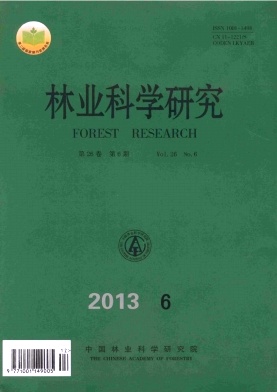Study on the Relationship between Water Conservation Function and Stand Factors in Dawujia Watershed, Inner Mongolia
-
1.
College of Ecology and Environmental Science, Inner Mongolia Agricultural University, Huhhot 010019, Inner Mongolia, China
-
2.
Forestry Administration of Huhhot City, Huhhot 010019, Inner Mongolia, China
-
Received Date:
2013-02-03
-
Abstract
Taking different forest types in Dawujia Watershed of Ao'han County, Chifeng city, Inner Mongolia as the research object, the correlation between water conservation function and stand factors was studied in order to evaluate the level of water conservation function by stand factors. The results of research show that the average height, the average diameter at breast height, crown width, crown thickness, volume per hectare, annual volume increment, canopy density, ground cover coverage, undergrowth coverage, and community structure are the most important factors impacting and related to water conservation function. These ten key factors can be used to evaluate the water conservation function of forest. For litter layer, the stand factors closely related to water conservation function are the average diameter at breast height (0.734 7), annual volume increment (-0.806 8), crown thickness (0.464 7), crown width (-0.674 6), community structure (-0.370 0), litter cover (0.677 6), volume per hectare (-0.617 9), and canopy density (-0.587 2); For soil layer, the stand factors closely related to water conservation function are the average height(0.592 1), the average diameter at breast height (0.275 0), volume per hectare (0.827 5), canopy density (0.317 3), annual volume increment (0.767 7), and crown width (0.749 0);For both the litter layer and soil layer, the stand factors closely related to water conservation function are canopy density (0.831 7), volume per hectare (0.817 2), undergrowth coverage (0.652 5), average diameter at breast height (0.644 7), and the crown width (0.521 2); From the viewpoint of the total water storage capacity of forest, the most important factors are the ground cover coverage (0.462 6) and the volume per hectare (0.315 5).
-

-
References
|
[1]
|
薛 立,李 燕,屈 明,等.火力楠、荷木和黎蒴林的土壤特性及涵养水源的研究[J].应用生态学报,2005,16(9):1623-1627
|
|
[2]
|
郝占庆,王力华.辽东山区主要森林类型林地土壤涵蓄水性能的研究[J].应用生态学报,1998,9(3):237-241
|
|
[3]
|
罗跃初,韩单恒,王宏昌,等.辽西半干旱区几种人工林生态系统涵养水源功能研究[J].应用生态学报,2004,15(6):919-923
|
|
[4]
|
李凌浩,林 鹏,王其兵,等.武夷山不同林龄甜储林水文学效应的比较研究[J].应用生态学报,1998,9(l):18-22
|
|
[5]
|
杨吉华,张光灿,张永涛,等.石质山地不同树种幼林涵养水源功能的研究[J].山东农业大学学报,1998,29(3):356-364
|
|
[6]
|
耿玉清,王保平.森林地表枯枝落叶层涵养水源作用的研究[J].北京林业大学学报,2000,22(5):49-52
|
|
[7]
|
马维伟,王 辉,王修华.甘南尕海不同湿地类型土壤物理特性及其水源涵养功能[J].水土保持学报,2012,26(4):194-198
|
|
[8]
|
罗柳娟,韦理电,何 斌,等.尾巨桉和厚荚相思人工林水源涵养功能研究[J].华南农业大学学报,2012,33(2):220-224
|
|
[9]
|
杜 燕,王 威,郑小贤.北京山区水源林结构与功能关系研究[J].林业资源管理,2011(4):59-65
|
|
[10]
|
王 威,郑小贤,宁杨翠.北京山区水源涵养林典型森林类型结构特征研究[J].北京林业大学学报,2011,33(1):60-63
|
|
[11]
|
余新晓,王春玲,牛 丽,等.流域防护林体系对位配置[M].北京:科学出版社,2010
|
|
[12]
|
张晓明,余新晓,武思宏,等.黄土区森林植被对坡面径流和侵蚀产沙的影响[J].应用生态学报,2005,16(9):1613-1617
|
|
[13]
|
秦富仓,余新晓,张满良,等.小流域林草植被控制土壤侵蚀机理研究[J].应用生态学报,2005,16(9):1618-1622
|
|
[14]
|
曾思齐,欧阳君祥.马尾松低质低效次生林分类技术研究[J].中南林学院学报,2002,22(2):13-16
|
|
[15]
|
张 峰,彭祚登、安永兴登.北京西山主要造林树种林下枯落物的持水特性[J].林业科学,2010,46(10):6-13
|
|
[16]
|
中国科学院南京土壤研究所.土壤理化分析[M].上海科学技术出版社,1980:33-45
|
|
[17]
|
孙艳红,张洪江,程金花,等.缙云山不同林地类型土壤特性及其水源涵养功能[J].水土保持学报,2006,20(2):106-109
|
|
[18]
|
裴喜春,薛河儒.SAS及应用[M].北京:中国农业出版社,1997:159-163,139-146
|
|
[19]
|
唐守正.多元统计分析法[M].北京:中国林业出版社,1991:99-120
|
|
[20]
|
林少宫.多元统计分析及计算程序[M].武汉:华中理工大学出版社,1999:55-69
|
-
-
Proportional views

-





 DownLoad:
DownLoad: